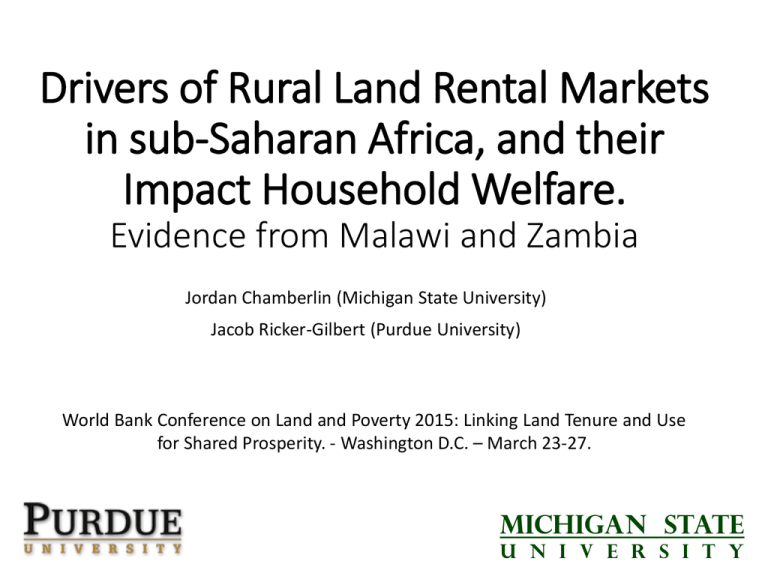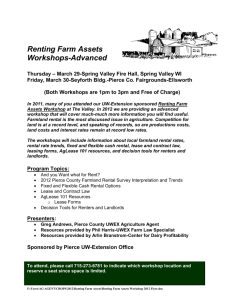Chamberlin-471-471_ppt
advertisement

Drivers of Rural Land Rental Markets
in sub-Saharan Africa, and their
Impact Household Welfare.
Evidence from Malawi and Zambia
Jordan Chamberlin (Michigan State University)
Jacob Ricker-Gilbert (Purdue University)
World Bank Conference on Land and Poverty 2015: Linking Land Tenure and Use
for Shared Prosperity. - Washington D.C. – March 23-27.
MICHIGAN STATE
U N I V E R S I T Y
Outline
• Motivation
• Theory
• Context: Malawi & Zambia
• Study objectives & contribution
• Methods
• Conceptual model
• Estimation issues
• Data
• Results
• Conclusions and next steps
2
Motivation
• Land is a key productive resource
• Especially important in agrarian economies with limited nonfarm sectors (e.g. Jayne et al. 2014)
• High and rising land scarcity in many parts of SSA
• Smallholders report limited expansion potential even in low
density areas! (e.g. Chamberlin 2013, for Zambia)
• High and rising inequality in landholdings
• Even within the smallholder sector (e.g. Jayne et al. 2003,
2014)
3
Role of land markets?
• Rental and sales markets should enable net transfers
of land
• From land-rich to land-poor equity gains
• From less-able to more-able farmers efficiency gains
• Enable productive livelihoods
welfare gains
• Especially for households with insufficient land…
• Such gains are conditional on efficient rental prices,
transactions costs of participation, etc.
Mixed evidence in the empirical literature (e.g. Holden et al. 2009)
4
This study
• Malawi & Zambia:
•
•
•
•
Most land under customary tenure
Zambia
High levels of land inequality and rural poverty
Similar agroecological, socioeconomic & legal contexts
Vary significantly in rural pop. density & market access
Malawi
• Research questions
• What are the trends in rental market development?
• Who is participating?
• What are the benefits?
• Efficiency
• Equity
• Implications for a variety of welfare outcomes
• Do participation and/or benefits vary with level of mkt dev’t?
5
Persons per km2
0-5
6 - 25
Malawi
26 - 50
51 - 100
101 - 200
Zambia
> 200
6
Household model: participation
• Ability: from Cobb-Douglass production function:
log(𝑄𝑖𝑡 ) = log(𝒙𝑖𝑡 )𝜷 + 𝑢𝑖 + 𝜀𝑖𝑡
we recover 𝑎𝑏𝑖𝑙𝑖𝑡𝑦𝑖 = 𝑢𝑖 from FE estimation
Jin & Jayne 2013
• Rental regime decision: ordered probit
𝑇𝑒𝑛𝑎𝑛𝑡
Rents in 𝑟
𝑖𝑡
𝐴𝑢𝑡𝑎𝑟𝑘𝑦
= 𝑓 𝑎𝑏𝑖𝑙𝑖𝑡𝑦𝑖 , 𝐴𝑖𝑡 , 𝒙𝑖𝑡
𝑟𝑖𝑡
𝑟𝑖𝑡𝐿𝑎𝑛𝑑𝑙𝑜𝑟𝑑
• Rental amount decision (ha): tobit
𝑃
𝑅𝑖𝑡
= 𝑓 𝑎𝑏𝑖𝑙𝑖𝑡𝑦𝑖 , 𝐴𝑖𝑡 , 𝒙𝑖𝑡 , P ∈ [𝑇, 𝐿]
Rents out
7
Household model: impacts
• Welfare:
𝑦𝑖𝑡 = 𝛾 𝑇 𝑟𝑖𝑡𝑇 + 𝛾 𝐿 𝑟𝑖𝑡𝐿 + 𝜁𝑎𝑏𝑖𝑙𝑖𝑡𝑦𝑖 + 𝒙𝑖𝑡 𝜷 + 𝜖𝑖𝑡
alt. specifications: binary vs continuous measures
𝑦𝑖𝑡 =
Value of crop production
Net crop income
Net off-farm income
Net total household income
Probability of expected deficit
# months staples expected to last
Subjective wellbeing (score: 1-5)
Probability of poverty
MWI
X
X
X
X
X
X
X
X
ZMB
X
X
X
X
X
8
Endogeneity in welfare model
• Concern that self-selection into rental market
participation may be an issue
• Omitted variable bias:
• Positive impact of “social capital” or something similar on
both participation decisions and on welfare outcomes
𝑦𝑖𝑡 = 𝒙𝑖𝑡 𝜷 + 𝜇𝑖 + 𝑢𝑖𝑡
FE? FD? Okay, but would lose key time-invariant
regressors of interest…
9
Endogeneity in welfare model
Mundlak-Chamberlain device
Correlation between covariates and unobserved
heterogeneity 𝜇𝑖 controlled for using MC device:
Auxiliary model:
𝜇𝑖 = 𝜓 + 𝒙𝑖 𝝃 + 𝑎𝑖 where 𝑎𝑖 = 0, 𝜎 2
the estimating equation is:
𝑦𝑖𝑡 = 𝒙𝑖𝑡 𝜷 + 𝜓 + 𝒙𝑖 𝝃 + 𝑎𝑖 + 𝑢𝑖𝑡
10
Data
Malawi household panel data
• 3 rounds: 2003/4, 2007, 2009
• 1,375 households in all waves
• Nationally representative
Zambia household panel data
• 2 rounds: 2001, 2008
• 3,736 households in both waves
• Nationally representative
Geospatial controls (both countries)
• Rural population density
• Access to markets
• Rainfall
11
This presentation
• Motivation
• Theory
• Context: Malawi & Zambia
• Study objectives
• Methods
• Conceptual model
• Estimation issues
• Data
• Results
• Conclusions and next steps
12
Rental status of the sample
15.4%
13.4%
8.9%
7.5%
4.3%
5.3%
3.0%
1.2%
0.9%
0.7%
0.1%
% renting in
0.5%
% renting out
13
Rental status of the sample
15.4%
13.4%
8.9%
7.5%
4.3%
5.3%
3.0%
1.2%
0.9%
0.7%
0.1%
% renting in
% renting out
0.5%
USD/ha rental rate
14
HH characteristics by rental status
Tenants
More education
More assets
More labor
Less land
Immigrants
>
>
>
<
≠
Landlords
Less education
Fewer assets
Less labor
More land
Local households
15
Determinants of rental market participation: Malawi
Partial effects from ordered probit model
Ability
Adult equivalents
Landholding (ha)
Female head (=1)
Education of head (years)
Age of head
Assets ('000*USD)
Immigrant (=1)
Mortality (=1)
Matrilineal (=1)
Lagged maize price (rainy)
Lagged maize price (harvest)
Log rainfall
Population density
Km to road
Central
South
N of Obs
(1)
Renting in
APE
p-value
0.0196 *** (0.000)
0.0126 *** (0.000)
-0.0354 *** (0.000)
-0.0010
(0.882)
0.0054 *** (0.000)
*
-0.0004
(0.072)
0.0017
(0.575)
0.0859 *** (0.000)
0.0013
(0.927)
-0.0073
(0.432)
-0.0982
(0.652)
*
0.4250
(0.083)
0.0233
(0.190)
0.0001
(0.335)
0.0002
(0.193)
0.0338 *** (0.001)
*
0.0201
(0.077)
6942
(2)
Autarky
APE
-0.0090
-0.0058
0.0162
0.0005
-0.0025
0.0002
-0.0008
-0.0561
-0.0006
0.0034
0.0450
-0.1946
-0.0107
-0.0000
-0.0001
-0.0134
-0.0066
6942
***
***
***
***
*
***
*
**
***
**
p-value
(0.000)
(0.000)
(0.000)
(0.876)
(0.000)
(0.081)
(0.563)
(0.000)
(0.932)
(0.454)
(0.655)
(0.087)
(0.181)
(0.326)
(0.209)
(0.002)
(0.048)
APE
-0.0106
-0.0068
0.0192
0.0005
-0.0029
0.0002
-0.0009
-0.0299
-0.0007
0.0038
0.0533
-0.2304
-0.0126
-0.0000
-0.0001
-0.0204
-0.0135
6942
(3)
Renting out
p-value
***
(0.000)
***
(0.000)
***
(0.000)
(0.888)
***
(0.000)
*
(0.071)
(0.587)
***
(0.000)
(0.923)
(0.416)
(0.650)
*
(0.085)
(0.201)
(0.347)
(0.188)
***
(0.003)
(0.102)
16
Determinants of rental market participation: Zambia
Partial effects from ordered probit model
(1)
Renting in
p-value
**
(0.019)
(0.845)
*
(0.099)
(0.196)
(0.944)
(2)
Autarky
APE
p-value
-0.0016 ** (0.035)
-0.0001
(0.851)
0.0001
(0.137)
0.0013
(0.659)
0.0000
(0.946)
Ability
Adult equivalents
Landholding (ha)
Female head (=1)
Education of head (years)
APE
0.0034
0.0002
-0.0002
-0.0042
-0.0000
Age of head
Assets (1000s USD)
Immigrant (=1)
Mortality (=1)
Matrilineal (=1)
Lagged maize price
Log lagged rainfall (mm)
-0.0002
0.0006
0.0125 **
0.0031
0.0030
0.0000
0.0095
(0.116)
(0.364)
(0.028)
(0.719)
(0.271)
(0.379)
(0.229)
0.0001
-0.0003
-0.0092 *
-0.0018
-0.0015
-0.0000
-0.0045
(0.230)
(0.353)
(0.088)
(0.758)
(0.332)
(0.407)
(0.229)
Population density
Km to road
N of obs.
-0.0001
0.0001
7,698
(0.304)
(0.311)
0.0000
-0.0000
7,698
(0.342)
(0.341)
(3)
Renting out
APE
p-value
-0.0018 *
(0.059)
-0.0001
(0.849)
0.0001
(0.150)
0.0029
(0.545)
0.0000
(0.946)
0.0001 *
(0.096)
-0.0003
(0.413)
-0.0033 *** (0.000)
-0.0012
(0.708)
-0.0015
(0.273)
-0.0000
(0.405)
-0.0049
(0.288)
0.0000
-0.0000
7,698
(0.331)
(0.325)
17
Welfare impacts: Malawi
Tenant (=1)
Landlord (=1)
Ha rented in
Ha rented out
Net total
Net
Value of
Net
household income
crop income
crop production
off-farm income
(USD)
(USD)
(USD)
(USD)
(7)
(8)
(3)
(4)
(1)
(2)
(5)
(6)
42.3451
72.3953
118.2320
-33.0360
(0.389)
(0.001)***
(0.000)***
(0.463)
-145.1319
-95.0686
-83.7949
-26.5993
(0.027)**
(0.018)**
(0.033)**
(0.467)
152.9715
180.5940
208.1458
-23.6094
(0.061)*
(0.002)***
(0.002)***
(0.662)
-169.7044
-135.8716
-105.8355
-17.7318
(0.068)*
(0.006)***
(0.012)**
(0.764)
18
Welfare impacts: Malawi [2]
Tenant (=1)
Landlord (=1)
Ha rented in
Ha rented out
Number of months
Subjective wellbeing
staples expected to last
(score: 1-5)
(9)
(10)
(11)
(12)
0.7085
0.1855
(0.027)**
(0.031)**
0.1100
-0.0017
(0.782)
(0.988)
1.2905
0.0574
(0.003)***
(0.546)
0.9751
-0.0857
(0.041)**
(0.572)
Probability of
poverty
(13)
(14)
-0.0943
(0.000)***
-0.0023
(0.913)
-0.0781
(0.000)***
-0.0088
(0.674)
19
Quantile regression results - Malawi
Dependent variable: Net crop income (USD)
Tenant (=1)
Landlord (=1)
(1)
10th
(2)
25th
(3)
50th
(4)
75th
(5)
90th
(6)
Mean
-8.0530
-3.5264
10.9125
42.3609
95.8327
72.3953
(0.091)*
(0.375)
(0.086)*
(0.001)***
(0.000)***
(0.001)***
-1.4830
(0.803)
-5.3225
(0.285)
-7.2555
(0.361)
-19.2919
(0.210)
-44.0652
(0.154)
-95.0686
(0.018)**
Returns to renting in and losses from renting out are skewed towards the top of the income
distribution.
Mean for tenants higher than 75th percentile for renting in.
20
Welfare impacts: Zambia
Tenant (=1)
Landlord (=1)
Ha rented in
Ha rented out
Value of
Net
Net
crop production
crop income
off-farm income
(USD)
(USD)
(USD)
(1)
(2)
(3)
(4)
(5)
(6)
156.31
68.51
-335.55
(0.039)**
(0.194)
(0.226)
-4.39
7.92
356.77
(0.950)
(0.905)
(0.159)
138.44
47.05
-10.18
(0.000)***
(0.002)***
(0.898)
-5.45
-4.76
6.77
(0.122)
(0.131)
(0.245)
Net total household
income
(USD)
(7)
(8)
266.49
(0.639)
471.39
(0.084)*
160.60
(0.226)
29.41
(0.007)***
21
Welfare impacts: Zambia [2]
Tenant (=1)
Landlord (=1)
Ha rented in
Ha rented out
Probability
of poverty
(9)
(10)
-0.0347
(0.534)
-0.4657
(0.000)***
-0.1604
(0.050)**
-0.4481
(0.092)*
22
Rental rate as a proportion of gross
value of crop production per hectare
(Malawi)
percentile
10th
25th
50th
75th
90th
tenants only
0.06
0.12
0.23
0.47
0.95
full sample
0.10
0.17
0.31
0.59
1.19
• Rental rates are high relative to production under
current productivity levels
23
Quantile regression results - Malawi
Dependent variable: Net crop income (USD)
Tenant (=1)
Landlord (=1)
(1)
10th
(2)
25th
(3)
50th
(4)
75th
(5)
90th
(6)
Mean
-8.0530
-3.5264
10.9125
42.3609
95.8327
72.3953
(0.091)*
(0.375)
(0.086)*
(0.001)***
(0.000)***
(0.001)***
-1.4830
(0.803)
-5.3225
(0.285)
-7.2555
(0.361)
-19.2919
(0.210)
-44.0652
(0.154)
-95.0686
(0.018)**
Returns to renting in and losses from renting out are skewed towards the top of the income
distribution.
Mean for tenants higher than 75th percentile for renting in.
24
Summarizing…
• Land rental markets more active in Mwi than Zmb
• Likely driven by necessity with much higher PD
• Market participation growing in both countries
• Land possibly being rented in by smallholders from
outside sector
• Mkt participation results very similar in Mwi & Zmb
• Efficiency gains: more able farmers rent in, less able rent out
• Equity gains: land-rich rent to land poor, and labor-poor rent
to labor-rich
25
Summarizing…
• Welfare impacts differ between Malawi & Zambia
• Malawi:
• Clear evidence of positive impacts on renting in, on average
• Small or negative impact from renting out, on average -- potential
evidence for distress rentals?
• Zambia:
• Smaller or no welfare impacts -- due to lower participation rates?
26
Summarizing…
• Even if renting in impacts are positive on average in
Malawi, cost of renting and other costs of production
are high relative to output
At the median, rental rates in
Malawi equal 1/3 the gross
value of production
• Most returns to renting in
captured at top of the distribution
• Raises questions about who has access to these rental
markets & liquidity required for up-front rental
arrangements
27
Policy recommendations
• Our findings suggest some key policy stances:
• Focus on creating enabling environment for rental market
participation
• Clarifying rights within customary tenure systems
• Complementary investments
• Productivity growth on small farms
• Welfare investments
28
Next steps for this work
• Joint modeling of Mwi & Zmb panel data
• Pooled panels
• Better measures of soil quality
• May affect land available to rent and thus impacts
• Take a closer look at rental rates
• Determinants of rental rates over space
• Determinants of rental participation at community
level
• Account for spillovers via spatial econometric model
29
Jordan Chamberlin, Michigan State University
chamb244@msu.edu
Jacob Ricker-Gilbert, Purdue University
jrickerg@purdue.edu
30





